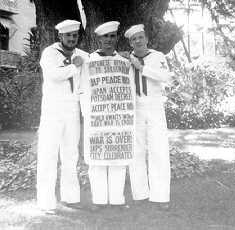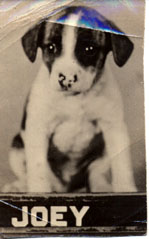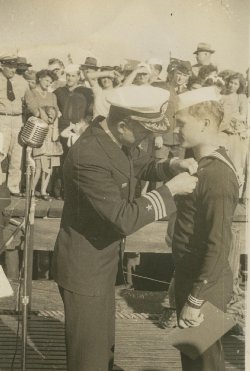



JAPANESE OFFER TO SURRENDER |
|
THE WAR IS OVER |
The following narrative of the voyage home was provided by Ens. Cas Hiatt who was assistant torpedo and gunnery officer as well as the commissary officer. He was the most junior officer aboard on the trip home.

As soon as we were clear of the harbor the Captain O’Neil ordered “four main engines on the- line, all ahead full” and we sped happily on our way. In due time, we changed to normal cruising speed. The Pacific Ocean is a huge body of water, bigger than anyone thinks and we soon became a miniscule speck on the surface. Somewhere near the middle of the ocean the vessel stopped and drifted in calm waters partially submerged with decks awash for a “swimming call.” A crew member with a rifle was stationed on the periscope platform with the expectation that he would repel any adventuresome shark. (In later years when I became better acquainted with sharks and their habits I realized this was an ineffectual precaution. The first sign of a marauding shark would have been, not a triangular fin but a bright red stain in the water.) Fortunately for all, no sharks were seen.
 |
Wednesday, September 5, 1945, Enroute Panama, C.Z. Our friend and mascot, "Joey", passed away, after a lingering illness. Cause unknown. "Joe", is survived by the officers and crew of the U.S.S. GUNNEL S253. "Joey" was buried at sea, enroute to Panama from Pearl harbor, T.H. in latitude 19.36 North, longitude 121.42 West. "Joey" made the eighth was patrol of this submarine off the island of Kyushu, Japan. When reaching Honolulu, Hawaii and while at the Royal Hawaiian Hotel, "Joey" fell sick and after a lingering illness passed away. "Joey" will be missed amoung the crew of this vessel, as everyone liked him very much. So long "Joey" |
I was on deck at daybreak when we made landfall on the Coast of Panama. There was a light offshore breeze carrying the definite smell of earth and vegetation. Twigs and leaves could be seen in the water and shore birds flying overhead. We established radio contact with our escort vessel, a navy patrol craft and followed her dutifully into the harbor at Panama City. There we berthed for refueling and maintenance while the crew, two sections at a time, went ashore to explore the city and especially to send telegraphs to families at home. Soon we began our transit of the Panama Canal stopping in Lake Gatun for another “swimming call.” This time in fresh water and no shark attacks expected.
At Colon, the eastern terminus of the canal, we entered the Atlantic and set course for New Orleans, where we remained at the Navy Yard for several months while Officers and crew went on leave, most traveling to their homes to become reacquainted with their families.
The day before the Gunnel was scheduled to leave New Orleans the Captain received the unwelcome news that three of the crew members were in jail in Baton Rouge. He gave me a bundle of cash from the ship’s “welfare fund” and I set forth to get the men out of jail. Apparently their incarceration followed a skirmish in a restaurant in which a gum dispensing machine had been propelled through a large plate glass window. I arranged for replacement of the window and apologized for the incident. The sailors were released from jail and we promptly boarded a bus headed for New Orleans.
At this point we realized the Gunnel had already departed and was proceeding down the Mississippi River. According to plan she would anchor near the mouth of the river before departing at daybreak. We took a bus that drove down the East side of the River and at each scheduled stop I asked if anyone had seen a submarine pass. When we finally came to the end of the line it seemed we would not be able to flag down the vessel as it passed. The bus driver who was sympathetic to our needs and outnumbered four to one agreed to depart from his schedule and drive us down an unimproved road which led to the Coast Guard base at the mouth of the river. By that time it was dark and the Coast Guard provided transportation to the anchorage where we were able to find the Gunnel and climb aboard with much relief to all hands
The Gunnel departed as scheduled at dawn.
 |
| Capt. O'Neil pinning a medal on Billy Stamper on Navy Day, 1945 |
 |
Here is a shot of Lloyd Berkey while the GUNNEL was in New Orleans. Lloyd donated many of the pictures seen on these pages. |
We proceeded to Pensacola FL for refueling and provisioning. Near the entrance to the harbor we were joined by another fleet submarine also approaching for provisioning. Each boat had a supply of eggs that were “overage in grade” and we decided to dispose of them by engaging in an egg throwing battle. Neither boat declared victory then each boat submerged to clean off the mess.
As commissary officer I went ashore to order new provisions following advice of various members of the crew. I purchased lots of fresh eggs and only the finest cuts of beef. One reason our hamburgers were so good thereafter- they were made of filet mignon. From Pensacola we made a pleasant and uneventful voyage around the tip of Florida and proceeded North along the Atlantic Coast. We encountered cold and stormy weather at Cape Hatteras. When ice began to form on deck and superstructure, crew members were sent on deck to chip away the accumulation of ice with axes which if excessive might have made it difficult to submerge in an emergency. After the storm abated we proceeded to the submarine base at New London, Connecticut. Sometime before arriving at New London, in an effort to identify the cause of a problem we experienced in diving believed to be a leak in the forward trim tank, I was selected from among the volunteers to crawl into the trim tank to find the source of the problem. As the hatch to the tank was bolted shut the Captain said in a jocular tone “If we have to dive, I will see that you get the Bronze Star.” My reply from inside the tank was, (I hope) inaudible. The source of the leak was easily detected and the need to repair added to our list of Deferred Maintenance.
 |
| GUNNEL getting underway for the long trip home. |
I was on watch one morning when we were ordered by base commander’s office to move to a different dock. I explained that we were not ready to get under way. Then I was reminded that we were under orders to maintain readiness to get underway. I dispatched a messenger to advise the Captain of this development and went below to verify that all necessary stations were manned. Many of them however were newly assigned crew members who were strangers to me. We started the engines and were leaving the dock when the Captain arrived. He thereafter was in charge but I remained on deck and was a keen observer of all that happened thereafter. The vessel was moved to the newly assigned dock in a routine manner. As we approached the dock the Captain ordered “All Back Full.” The engines went All Ahead Full. The vessel gained speed and the Captain ordered “All Back Emergency” but the engines went All Ahead Flank. The next command was “All Stop” but it was too late. The bow hit the concrete seawall causing severe damage to both the vessel and the dock. (During this episode each of the verbal orders was accompanied by the identical message on the engine room telegraph) This colossal error in communication occurred in the maneuvering room where an inexperienced operator pulled the wrong levers. While the damage was severe, the vessel remained safely afloat and shortly after dockage was completed, repairs to the tank were undertaken. The following day, again on my watch, a welding crew arrived prepared to cut away and replace the damaged portions of the bow. I stationed a crew member in the forward trim tank with a fire hose to direct a stream of water on the inside of the tank to prevent overheating of the combustible insulation. As a precaution, I had tied a one inch manila line around the chest of the man in the tank. The line led up to the deck where it was manned by a sailor on watch. This was intended to rescue the sailor in the tank if necessary. I went below to continue writing my description of the collision and shortly afterward heard the sound of an explosion. Rushing to the deck I encountered the sailor holding the rope which had been burned through and realized the tar-like lining had indeed caught fire. The man in the tank had made his escape through a limberhole, swum to the dock, climbed aboard, showered, changed his clothes ,and showed up to see what was going on. The fire was soon suppressed and repairs to the hull resumed.
After I completed my report of these two disasters which had occurred on my watch I was not unprepared when I received orders to report to San Francisco en route to an assignment as navigator on a troop ship to Okinawa. Following orders en route I was stationed at Great Lakes Naval Station near Chicago awaiting transportation to Okinawa. I was assigned the temporary duty of monitoring and assessing requests of naval Reserve officers for release to inactive duty. After several weeks of this task I processed my own release and sent it in. I remained in Inactive Reserve until I was ordered back to active duty during the Korean War. At that time I was a civilian employee at Walter Reed Army Medical Center, Chairman of the Department of Veterinary Chemistry. The army requested that I be deferred from this assignment. The Navy personnel department maintained that if this deferment was to be honored I should transfer to Army Reserve. This would have given me the rank of 1st. Lt. in the Army. Since I was head of a department that included one Major and several captains it did not seem like a viable option. I resigned from the Naval Reserve and remained at Walter Reed.
